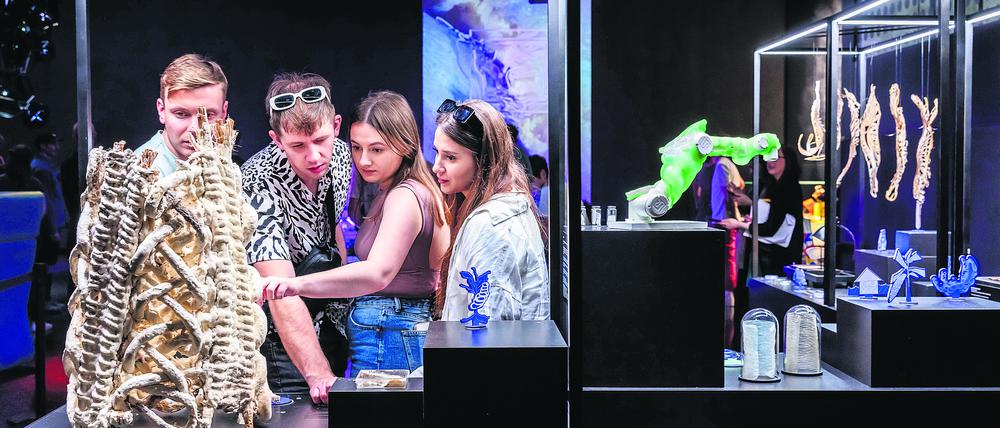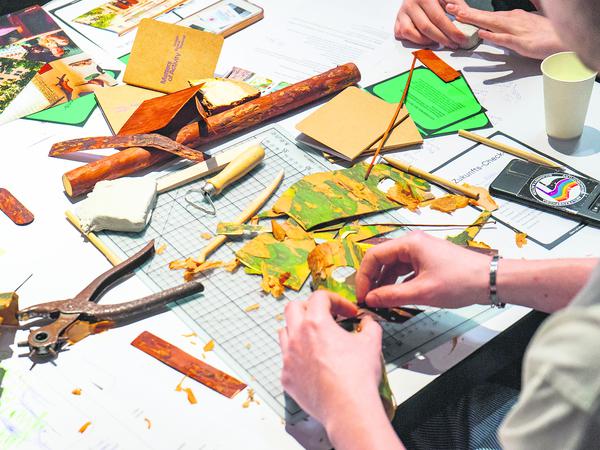
© David von Becker
Speculative design as a research principle: What could be?
In light of growing global uncertainties, the future is less predictable than ever before. Speculative design aims to stimulate reflection with alternative scenarios – and to show that the future can be shaped.
Stand:
In an era of rapid social upheaval, technological revolutions, and ecological crises, the question of the future is becoming ever more urgent: How will we – and above all: how do we want to – live in the future? How will our cities, our environment and our material culture change? Instead of only looking for the answers to these questions in figures, trends and models, we need creative tools that enable us not only to predict the future, but to proactively shape it. This is where speculative design comes in – an approach that combines design, science, and philosophy and can be understood as a new interdisciplinary research principle.
Today, the future is mostly thought of in terms of data: forecasting models from climate research, business, and technology attempt to make the future predictable. However, in the face of growing global uncertainties, it is becoming clear that the future is less predictable than ever – rather, it is open, complex, and full of disruptions. Speculative design counters the idea of predictability with a new approach.
Instead of asking: ‘What is likely to happen?’, the question is: ‘What could be?’ It’s not about making precise predictions, but about designing alternative future scenarios – strange, utopian, perhaps even dystopian visions that are intended to inspire reflection. Traditional design disciplines, but also science and research can benefit from this approach.
Speculative design emerged from the desire to develop design processes that went beyond purely functional or commercial purposes. Its roots go back to the 1960s and 1970s, when radical collectives such as Archigram (UK) or Superstudio (Italy) questioned social norms with visionary architectural designs.
Their work viewed design not as a mere service, but as a means of imagination and criticism. At this time, futurology was also gaining in importance – and became a significant source of inspiration for speculative design. Design was increasingly understood as a future-oriented process that was intended to transform existing situations into desirable ones, as described by Nobel Prize winner Herbert A. Simon.
Speculative design can provide an impetus by making other planetary futures imaginable and negotiable.
Claudia Mareis, Scientist
British designers Anthony Dunne and Fiona Raby further developed the speculative design approach in the 1990s. In their book „Speculative Everything“ (2013), they called for an understanding of design as an instrument of collective imagination – as a method for making visible possible, probable, and desirable futures.
Speculative design concepts often seem absurd or irritating: A refrigerator that makes ethical decisions. Drugs that erase memories. A parliament for animals. These kinds of ideas are rarely functional – but that’s precisely their intention and power. They aim to provoke controversial debates. The future is not understood as a linear continuation of the present, but as something that could be fundamentally different.
Between design, science and philosophy
At first glance, speculative design seems like an artistic experiment – playful, provocative, sometimes utopian. But on closer inspection, it fulfils central scientific functions: It formulates hypotheses, questions assumptions, and opens up new fields of inquiry – similar to classical thought experiments in physics or philosophy. In this sense, speculative design can be understood as a new research principle: It doesn’t provide empirical evidence, but offers new perspectives and thus adds to knowledge.
Particularly in those fields where traditional methods are reaching their limits – such as climate research, bioethics, artificial intelligence, or social policy – speculative design can provide an impetus by making other planetary futures imaginable and negotiable. What would a world without fossil fuels look like? Or a future in which plants take over the function of computers?
Speculative design makes it clear that the future is not an inevitable fate.
Claudia Mareis, Scientist
A central concern of speculative design is the democratisation of the future. After all, who actually shapes it? Politicians, tech companies, scientists – or perhaps also all of us? By making future scenarios visually and materially tangible, speculative design actively involves society. In museums, schools, urban projects, or participatory formats, such as the experimental laboratory CollActive Materials funded by the Berlin University Alliance, spaces are being created in which people are coming together to speculate about future material culture.

© 2025 Collactive Materials
The aim is to develop speculative design as a new approach for the exchange of knowledge between research institutes and society. Questions such as „What will connect us in the future?“ or „Could active and intelligent materials play a decisive role in this?“ encourage debate – open, political, participatory. This step towards collaborative knowledge production has become indispensable for university research, both in terms of expanding its own repertoire of knowledge and its acceptance by the public and society.
Criticism and limits of speculative design
Despite its innovative power, speculative design has also been subject to criticism. Some projects are accused of being too abstract or detached – far removed from the reality of many people’s lives. These scenarios often only reach an audience that is academic or interested in art, while broader social groups don’t feel addressed. Occasionally, speculative designs also threaten to become an end in themselves – as aesthetically stylised objects without any social depth.
There has also been criticism that speculative projects are often created from a Western academic perspective and therefore ignore alternative cultural visions of the future. What appears dystopian in Europe, for example – such as uninhabitable regions due to climate change or completely digitalised cities – has long been a reality in other parts of the world. For speculative design to have a real impact, it must therefore be inclusive, accessible and context-sensitive. Above all, it must be aware of its own implicit assumptions and privileged perspectives.
The future can be designed
In a world that many perceive as uncontrollable and overly complex, speculative design – despite justified criticism – offers a promising, perhaps even indispensable approach to shaping future knowledge. It makes it clear that the future is not an inevitable fate that we are passively at the mercy of, but is also a question of our imagination and creative power. Of course, every design entails ambivalent potential: It can change the world for the better or for the worse. Speculative design therefore challenges us to take responsibility – for the futures we are striving for, as well as for those we want to avoid.
Conceived as a research principle, speculative design can help to develop innovative research questions, build interdisciplinary bridges and stimulate social debate. It is not a substitute for science or politics, but rather a supplement: a method for making the unthinkable conceivable and the invisible visible. Speculative design brings research, design and society together in a new way. It opens up explorative spaces in which we can think differently about the future by means of thought experiments and develop a pluralistic concept of the future. After all, anyone who wants to talk about a better future must first be able to imagine it.